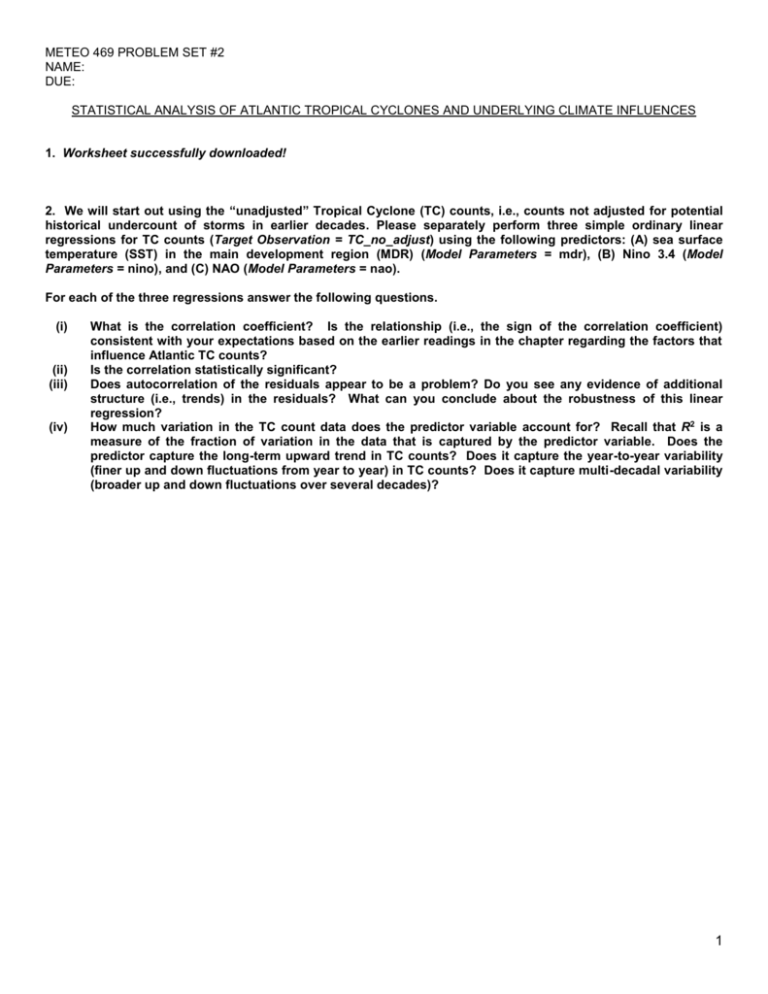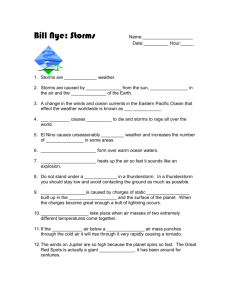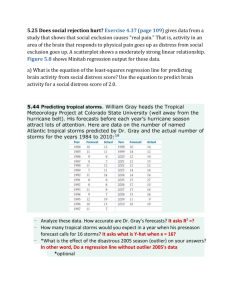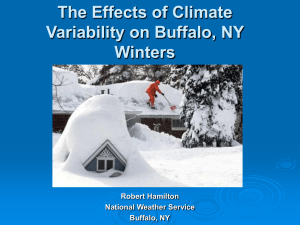Problem Set #2 Worksheet
advertisement

METEO 469 PROBLEM SET #2 NAME: DUE: STATISTICAL ANALYSIS OF ATLANTIC TROPICAL CYCLONES AND UNDERLYING CLIMATE INFLUENCES 1. Worksheet successfully downloaded! 2. We will start out using the “unadjusted” Tropical Cyclone (TC) counts, i.e., counts not adjusted for potential historical undercount of storms in earlier decades. Please separately perform three simple ordinary linear regressions for TC counts (Target Observation = TC_no_adjust) using the following predictors: (A) sea surface temperature (SST) in the main development region (MDR) (Model Parameters = mdr), (B) Nino 3.4 (Model Parameters = nino), and (C) NAO (Model Parameters = nao). For each of the three regressions answer the following questions. (i) (ii) (iii) (iv) What is the correlation coefficient? Is the relationship (i.e., the sign of the correlation coefficient) consistent with your expectations based on the earlier readings in the chapter regarding the factors that influence Atlantic TC counts? Is the correlation statistically significant? Does autocorrelation of the residuals appear to be a problem? Do you see any evidence of additional structure (i.e., trends) in the residuals? What can you conclude about the robustness of this linear regression? How much variation in the TC count data does the predictor variable account for? Recall that R2 is a measure of the fraction of variation in the data that is captured by the predictor variable. Does the predictor capture the long-term upward trend in TC counts? Does it capture the year-to-year variability (finer up and down fluctuations from year to year) in TC counts? Does it capture multi-decadal variability (broader up and down fluctuations over several decades)? 1 3. Next please perform a multivariate regression using all three predictors simultaneously (Target Observation = TC_no_adjust; Model Parameters = mdr, nino, and nao). (i) (ii) (iii) (iv) How much of the total variation in the data does your regression model capture? Based on the model coefficients, which factors are most important? Given the coefficients, the model equation is TC c0 c1 mdr c2 nino c3 nao ; so the greater the magnitude of the coefficient for a given variable, the more this variable contributed to the result. Does autocorrelation of the residuals appear to be a problem? Briefly discuss why multivariate regression model is superior to the single predictor regressions from Question 2. 2 4. Repeat the analyses (i) through (iii) in Question 3 using (A) “lightly adjusted” TC count series (Target Observation = TC_light_adjust), where a modest undercount bias is assumed prior to aircraft reconnaissance (i.e., and undercount of roughly 1 storm per year before 1944) and (B) “heavily adjusted” TC count series (Target Observation = TC_heavy_adjust), where a more substantial underestimation bias is assumed (i.e., roughly 3 storms per year prior to 1944). How, if at all, did your conclusions change? 3 5. Using the regression model based on the “lightly adjusted” TC series, please make a prediction for the number of TCs that we should have seen during the 2010 Atlantic Hurricane season. Assume that MDR SSTs were roughly equal to their 2005 value: read the value off the SST plot; there was a modest La Nina event: take Nino 3.4 index to be -0.5; NAO was neutral: use the long-term average of the NAO series. Round off your estimate to the nearest whole number and call the result N. Calculate the 95% confidence interval for your prediction, assuming that the interval is N 2 N . 4 6. Compare your prediction to the prediction made prior to the beginning of the 2010 Atlantic Hurricane season by the Penn State statistical model. The Penn State model predicted 23.4 4.8 storms, which corresponds to between 19 and 28 storms, with the best estimate of 23 storms. Next, compare your prediction to the actual observed total for 2010: 19 storms. Is your prediction consistent with the observed counts within the statistical uncertainty. 5






